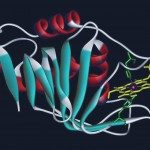Lien vers Pubmed [PMID] – 9220983
Biochemistry 1997 Jul;36(29):8954-61
Monoclonal antibody mAb164 is directed against the TrpB2 subunit of the Escherichia coli tryptophan synthase. It recognizes the synthetic peptide P11, constituted of residues 273-283 of TrpB, with high affinity. We constructed a hybrid protein in which the C-terminal end of protein MalE was linked with the N-terminal end of P11. Hybrid MalE-P11 was produced in E. coli from a plasmidic gene and purified in one step as MalE. MalE-P11 and the isolated P11 had identical conformational and functional properties according to the following criteria. The NMR spectra of MalE and MalE-P11 in TOCSY experiments showed that the P11 moiety of MalE-P11 moved independently from its MalE moiety. The chemical shifts of the protons for the P11 moiety of MalE-P11 and for the isolated P11 were very close and did not show significant deviations from random coil values. The equilibrium constant of dissociation (KD) from mAb164, measured by a competition ELISA, was identical for MalE-P11 and the isolated P11, around 6 nM. The change of the C-terminal residue of MalE-P11 from Lys into Ala increased 37-fold this dissociation constant. This increase showed that the P11 moiety of MalE-P11 was not degraded. The high molecular mass of MalE-P11 allowed us to follow its kinetics of interaction with immobilized mAb164 by surface plasmon resonance, using the BIAcore apparatus. The rates of association with mAb164 were similar for MalE-P11 and TrpB2, but the dissociation was faster for MalE-P11 than for TrpB2, as previously observed for the isolated P11 by a fluorometric method. Thus, the fusion of peptides with the C-terminal end of MalE could constitute an alternative to chemical synthesis for the study of their recognition by receptors, in vivo or in vitro.

